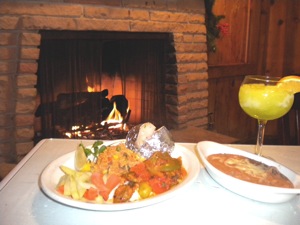dining out
Epicurious Eating: El Fandango
Culinary derivatives of the Old West?
Published Thursday, 17-Dec-2009 in issue 1147
Dining after sunset early in the week has become so abysmally low-beat in this static economy that you can essentially show up at restaurants wearing sweats and fuzzy slippers without being spotted by anyone you know. With colder nights and the holiday season upon us, your chances of walking into completely lifeless dining rooms are even greater.
Touristy Old Town is no exception.
Visiting El Fandango at about 7:30 p.m. on a Monday, my companion and I arrived to a packed parking lot (accessible from Juan Street), but only to discover that the entire patronage was clustered in an upstairs banquet room for a private party. Ample parking was available on the street, a normally rare finding in these necks.
From start to finish, we were the lone customers in a Spanish-themed ramada warmed by an active fireplace and embellished with wood beam ceilings, stone-tile flooring and antiquated oil paintings. Bric-a-brac is kept to a minimum, although not so charming is bright overhead lighting that demands a dimming switch. From the bar area is a partially covered outdoor patio brimming with shrubbery that appears to offer fun possibilities in warmer weather.
The preface on El Fandango’s menu summarizes in choppy grammar fleeting cooking patterns that occurred in this region from 1846 to 1856, thus claiming to capture them in dishes such as ginger-chicken salad, super nachos and crab-stuffed shrimp. Food historians would surely argue the menu’s inference stating that these recipes “reflex” the culinary influences introduced specifically during that period by French, English, Hawaiian and Alaskan émigrés. It’s plausible that the Spaniards were folding beef and seafood into tortillas while local Indians reveled in game. But was anyone back then really stuffing lamb chops with feta cheese and mushrooms?
In its jumbled flaunt of historically cosmopolitan cuisine, the menu progresses into more traceable preparations of fish, mole sauces and chicken-stuffed crepes drenched in tarragon-cream sauce, an obvious French-inspired dish that magnetized my companion’s fork and must have incited somersaults among the early “Californios.”
An appetizer of shrimp Consuelo, however, failed to deliver the French kiss promised in its description. The crab-stuffed crustaceans swirled in bacon were supposed to come with Béarnaise sauce, but instead came with sour cream. A pair of empanadas better captivated us with their homey hash-like filling of ground beef, potatoes and carrots encased in what seemed like fresh croissants. Moist and steamy in the traditional Spanish style, the accompanying salsa served no purpose.
Fandango’s albondigas soup was also a winner, nurturing every membrane of our mouths with its cilantro-infused broth dancing in lockstep with clear beef juices. Immersed in each of our bowls was a large hamburger-rice meatball providing savory texture – and heartbreak when they were gone.
Despite the restaurant’s international aim, most dishes are laced with common Mexican elements – guacamole, Jack cheese and mildly seasoned rice. The refried beans leave satisfying aftertastes of garlic and cumin. And naturally, there are tacos, burritos, enchiladas and combinations thereof, not to mention complimentary table chips served with safely spiced salsa to oblige visiting convoys from the Prairie States.
In addition to the aforementioned chicken crepes, which would have been flawless with half the amount of tarragon sauce, we rounded out our entrée course with “hauchinango,” a filet of grilled red snapper covered prudently in tomato Vera Cruz. The chunky red topping, which originates from the namesake southern Mexican state straddling the Gulf, lacked the classic garlic punch, but rightfully captured the flavors of thyme, bay leaves and jalapeno pickling juices. Pity the fish wasn’t as moist.
For dessert we split a slice of homemade cheesecake lacking any gourmet surprises, just creamy filling set over thin graham cracker crust.
The margaritas on the other hand pack walloping blows of tequila. They’re available in several varieties, including one sweetened with Midori melon liqueur, which converts the drink from frothy white to groovy green.
Service was erratic. Our soup came rushing at us before we could finish half of our appetizers, and at one point I stole from a nearby table to replace our silverware. Spent plates weren’t bussed in a timely manner, or in the case of our emptied entrées, those plates idled at the table until our bill arrived. Our waiter was nonetheless gracious as he earnestly aspired to formality.
Would I send visitors here who are deprived of Mexican food in their hometowns? Absolutely. Were we convinced that El Fandango’s menu afforded us a snapshot of mid-19th-Century eating? Not really.
|
| |||||||||||||||||||||||||||
Copyright © 2003-2025 Uptown Publications


